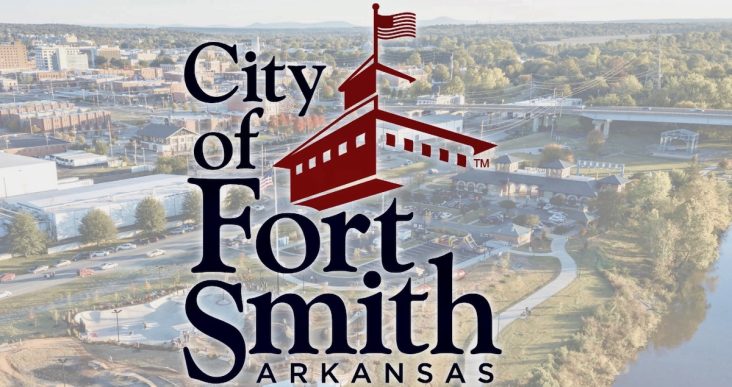Mobility plan concepts presented to Fort Smith Board
by August 14, 2024 8:58 am 597 views

A mobility plan for the city of Fort Smith, presented at a Fort Smith Board of Directors meeting Tuesday (Aug. 13), suggests a number of ways to help move people around the city safely and efficiently.
“The Move Fort Smith Plan is one more way for the City of Fort Smith to live out its motto as Arkansas’s Trailblazing City. It is reflective of the character of Fort Smithians to overcome the challenges of our day with grit and determination,” noted Michael Ming, the city’s mobility coordinator. “The success of this plan will depend on the collective effort and dedication of the entire community. … Together, we can create a city where walking, biking, and rolling are enjoyable and integral aspects of everyday life for Fort Smith residents.”
The plan reviews existing conditions and previous planning documents and then looks at the expansion of mobility facilities including shared-use paved paths, mixed traffic alleyways, bicycle facilities, and pedestrian facilities.
Projects suggested in the plan are prioritized based on several factors, including the proximity to schools, parks and employment centers, which Ryan Hale said were three of the main things citizens participating in surveys and meetings wanted from the trailways.
Hale is with Bentonville-based Laneshift, a consulting firm that specializes in bicycle and pedestrian planning and design, that was hired by the city to help develop the plan. Hale said the highest priorities to community mobility, according to citizen feedback, were sidewalks, paths and facilities.
“This is a living breathing document that doesn’t outline rules, but gives tools,” Hale said.
BASS REEVES LOOP
The plan focuses on the needs of vulnerable populations, including low-income families with health disparities and disabilities, recommends improving connectivity in historically underserved neighborhoods, and updating recommendations from the latest traffic control manuals for mobility safety best practices, Ming said. It includes strategies to address non-motorist crashes and improve overall safety and promote active lifestyles.
The mobility master plan is looking to create nine miles of new greenways, rehabilitate alleyways and improve B Street mobility.
The city applied for, but did not receive a $25 million, federal RAISE grant for the Bass Reeves Legacy Loop, a 14-mile greenway loop with new and existing trails that was first discussed in May. The loop would include nine miles of new trails giving a safe route to schools, parks, jobs, medical care and essential services, Mings said, adding that 20% of Fort Smith residents will live within a half mile of the loop. The loop would connect eight schools in order to allow students to more safely walk or ride bikes to schools, Mings said.
“RAISE is highly competitive, and it takes some municipalities years before their projects are approved. I believe the Bass Reeves Legacy Loop is a great fit for RAISE and a worthy project to continue pursuing. The City of Fort Smith will submit an application for the project again next year,” Ming said. “In the meantime, we have local resources at hand that we can use towards advancing the project and preparing to submit a stronger application for next year. We are also looking at other grant programs to help fund sections of the BRLL.”
NORTHSIDE CONNECTIONS
The Move Fort Smith Plan did help the city receive a $14.5 million grant from the Environmental Protection Agency (EPA) that will partially help the plan’s alley rehabilitation project. The project focuses on nearly three miles of alleywork networks on the north side of the city that will become paved greenways connecting the northside of town to grocery stores, Northside High School, places around Grand Avenue and more, Ming said.
Three alleyways – North E Street to North O Street, North 16th Street to Belle Avenue, and North C Street to Tilles Avenue – are included in the plan with a total estimated cost of $5.1 million. The alleyways will be a shared use facility but more like a trail or greenway. They would allow local access to backyards and backs of homes, Ming said.
“The Move Fort Smith plan is already proving its value even before adoption,” Ming said. “Additionally, even as we speak, a local real estate developer has taken plans to the planning commission that will utilize recommendations from the Move Fort Smith Plan. If approved, the new development will build sections of the greenway that will serve to better connect new neighborhoods to schools, retail and other community services,” Ming said.
In the plan, all proposed catalytic projects, shared-use paved paths, on-street infrastructure, alleyways, and sidewalks have been prioritized based on several factors, including access to open spaces, school walk accessibility, access to employment hubs, and connection to transit services.
The plan recommends a 10-year phasing plan that can inform the city’s focus and help prioritize which projects to pursue within certain time frames. Phase One projects include the Bass Reeves Legacy Loop, Ninth and 10th Street alleyways, a west side bikeway, safety improvements to B Street, a greenway from Brooken Hill Drive to Ben Geren Regional Park, and an eastside greenway.
“It is our recommendation that the Move Fort Smith Plan replaces the Trails and Greenways master plan that was first adopted in 2004,” Ming said.
Directors agreed to put the plan on the agenda for an upcoming board meeting.
